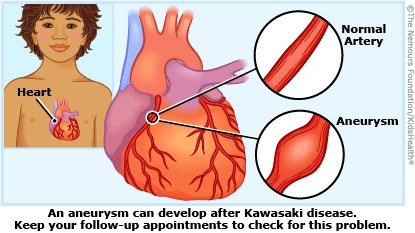Kawasaki Disease: How to Care for Your Child
Most children with Kawasaki disease who are treated early recover fully. Treatment is important since the disease can cause heart problems.


Symptoms of Kawasaki disease can include a high fever that lasts for several days; eye redness; a widespread rash; dry, cracked lips; a swollen tongue with red bumps; swollen lymph nodes; and swollen palms and soles of the feet. Later on, a child may have peeling of the skin of the hands and feet, diarrhea, vomiting, belly pain, or joint pain. The cause of this disease is unknown.
Problems of the heart or blood vessels sometimes occur, but early treatment can make this less likely.
While in the hospital, your child received treatment for Kawasaki disease to help prevent heart and blood vessel problems. Your child may need to continue to take a low dose of aspirin or other medicine at home. After going home, your child may still be cranky and tired. It can take several weeks for your child to feel completely better.

-
Give your child any medicine prescribed by the health care provider as instructed.
-
Allow your child to rest when tired.
-
Follow the health care provider's instructions about when your child can return to school and other activities.

-
Make sure your child attends all follow-up visits. Heart problems may not show up right away, so your child's heart will be watched closely.
-
Talk to the health care provider about getting the flu shot for your child and others in the household so that your child does not get the flu while on aspirin treatment. Getting the flu while taking aspirin may increase the chance of developing Reye syndrome, a rare but serious illness.
-
Ask your health care provider if there should be any changes to your child's routine vaccination schedule. The medicines that health care providers use to treat Kawasaki disease can affect when your child should receive certain vaccines.

Your child:
-
Develops a fever again more than 36 hours after receiving intravenous (IV) gamma globulin treatment.
-
Is taking aspirin and is exposed to the flu or chickenpox.
-
Is getting more tired, has a return of symptoms that had improved, or develops new symptoms.
-
Seems worse or is not improving.

Your child:
-
Has chest pain, shortness of breath, or trouble breathing.
-
Has abdominal pain or vomiting.
-
Looks pale or is dizzy.
-
Faints.
-
Has trouble walking, talking, or moving.
-
Appears dehydrated; signs include dizziness, drowsiness, a dry or sticky mouth, sunken eyes, producing less urine or darker than usual urine, crying with little or no tears.